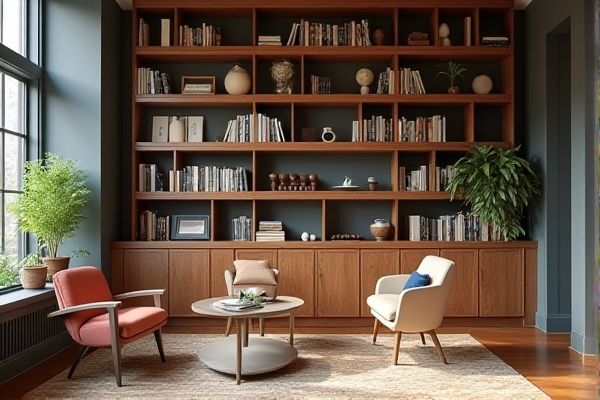
Open back bookshelves offer a lightweight, airy look that enhances room openness and allows wall art or paint to remain visible, while closed back bookshelves provide added stability and protect walls from damage, making them ideal for heavier books or a more polished appearance. Explore the rest of this article to discover which bookshelf style best suits your space and storage needs.
Table of Comparison
| Feature | Open Back Bookshelf | Closed Back Bookshelf |
|---|---|---|
| Design | Exposes wall behind, creates open airy feel | Solid panel back, offers traditional look |
| Stability | Less stable, may wobble without wall support | More stable and sturdy due to back panel |
| Wall Protection | Minimal protection, items visible from back | Protects wall from shelf contents, hides cords |
| Weight Capacity | Usually lower due to open structure | Higher, supports heavier items better |
| Airflow & Dust | Better airflow, but dust passes through easily | Restricts airflow, reduces dust accumulation |
| Installation | Easier to install and move | Requires secure mounting for support |
| Use Cases | Showcasing decorative items, open spaces | Ideal for hiding wires, storing heavy books |
Introduction to Bookshelf Speaker Designs
Open back bookshelf speakers use a rear-firing design that allows sound to blend with the room's acoustics, creating a more natural and spacious audio experience. Closed back bookshelf speakers feature an enclosed rear panel that enhances bass response and reduces sound leakage, delivering a tighter and more focused soundstage. Choosing between open back and closed back designs depends on room environment, desired sound characteristics, and placement options.
What Are Open Back Bookshelf Speakers?
Open back bookshelf speakers feature a rear grille or are partially open, allowing sound to radiate from the back as well as the front, resulting in a more natural and expansive audio experience. Your listening environment plays a critical role, as open back designs rely on room acoustics to enhance soundstage and imaging. These speakers are ideal for rooms where reflections and ambient sounds can complement the speaker's output, offering a spacious, airy feel compared to closed back bookshelves.
What Are Closed Back Bookshelf Speakers?
Closed back bookshelf speakers feature a sealed rear enclosure that prevents sound waves from the back of the speaker driver from interfering with those at the front, resulting in tighter bass response and improved sound clarity. These speakers minimize unwanted resonance and reduce sound leakage, making them ideal for environments where sound isolation and accuracy are important. Closed back designs enhance audio precision by controlling airflow and preventing phase cancellation, delivering a more focused and detailed listening experience compared to open back models.
Acoustic Differences: Open Back vs Closed Back
Open back bookshelves allow sound to flow freely, reducing resonance and preventing sound waves from bouncing back, which can minimize echo in your room. Closed back bookshelves create a reflective surface that enhances sound resonance, often enriching bass response but potentially causing unwanted reverberation. Understanding these acoustic differences can help you choose the best bookshelf design to optimize sound quality in your living or work space.
Soundstage and Imaging Comparison
Open back bookshelves provide a more expansive soundstage with improved imaging due to fewer reflective surfaces behind the drivers, allowing sound waves to disperse more naturally. Closed back bookshelves enhance bass response by preventing sound leakage and offer tighter imaging with a more focused soundstage, benefiting listeners in untreated rooms. The choice depends on room acoustics and personal preference for either open spatiality or controlled sound projection.
Room Placement Considerations
Open back bookshelves enhance natural light flow and maintain spaciousness, making them ideal for small rooms or areas with limited lighting. Closed back bookshelves provide a solid backdrop, perfect for against walls to prevent items from falling and to add visual weight in larger spaces. Consider room size, lighting, and functional needs when choosing between open and closed back designs for optimal placement.
Use Cases: Home Theater, Music, and More
Open back bookshelves enhance sound quality in home theaters and music rooms by allowing speakers to project without obstruction, improving acoustics and bass response. Closed back bookshelves provide additional storage privacy and wall protection, useful for organizing media collections and reducing sound bleed in shared spaces. Each design suits specific needs: open backs optimize audio performance, while closed backs offer practical storage and sound isolation.
Aesthetics and Space Requirements
Open back bookshelves create an airy, spacious feel by allowing light and wall color to show through, perfect for showcasing decorative items and making small rooms appear larger. Closed back bookshelves offer a more solid, traditional aesthetic, providing a clean backdrop that highlights your books and protects the wall from scuffs. Your choice between the two depends on whether you prioritize openness and light flow or a structured, intentional display space.
Price Differences and Value
Open back bookshelves typically cost less than closed back versions due to simpler construction and reduced materials, offering budget-friendly storage options. Closed back bookshelves provide greater durability, enhanced protection from dust, and improved wall support, adding value for long-term use and stability. Your choice depends on balancing upfront savings with the potential benefits of added security and finish quality in a closed back design.
Which Bookshelf Speaker Design is Right for You?
Open back bookshelf speakers deliver a spacious, natural soundstage by allowing air and sound to flow freely, making them ideal for audiophiles seeking detailed, immersive audio. Closed back bookshelf speakers offer tighter bass response and better isolation from room noise, perfect for environments where sound leakage or acoustic control is crucial. Your choice depends on whether you prioritize open, airy sound or focused, controlled audio performance in your listening setup.
 homyna.com
homyna.com